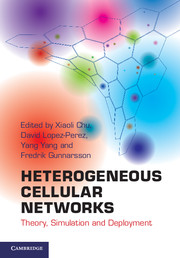Book contents
- Frontmatter
- Contents
- Acknowledgments
- Forewords
- Preface
- List of contributors
- Acronyms
- 1 Introduction
- 2 Radio propagation modeling
- 3 System-level simulation and evaluation models
- 4 Access mechanisms
- 5 Interference modeling and spectrum allocation in two-tier networks
- 6 Self-organization
- 7 Dynamic interference management
- 8 Uncoordinated femtocell deployments
- 9 Mobility and handover management
- 10 Cooperative relaying
- 11 Network MIMO techniques
- 12 Network coding
- 13 Cognitive radio
- 14 Energy-efficient architectures and techniques
- Intex
1 - Introduction
Published online by Cambridge University Press: 05 June 2013
- Frontmatter
- Contents
- Acknowledgments
- Forewords
- Preface
- List of contributors
- Acronyms
- 1 Introduction
- 2 Radio propagation modeling
- 3 System-level simulation and evaluation models
- 4 Access mechanisms
- 5 Interference modeling and spectrum allocation in two-tier networks
- 6 Self-organization
- 7 Dynamic interference management
- 8 Uncoordinated femtocell deployments
- 9 Mobility and handover management
- 10 Cooperative relaying
- 11 Network MIMO techniques
- 12 Network coding
- 13 Cognitive radio
- 14 Energy-efficient architectures and techniques
- Intex
Summary
Mobile broadband demands are increasing rapidly, driven by the popularity of various connected mobile devices with data services, such as smartphones, tablets, vehicles, machines and sensors. The notion of connected devices actually expands to encompass basically everything that can take benefits from a wireless connection. A true mobile broadband experience of high quality everywhere can be expected by consumers in the near future.
Mobile applications have become an indispensable part of people's everyday life, with requirements on seamless access to social media, video contents and cloud-based contents anytime, anywhere. To provide services that meet these requirements is of top priority for operators with ambitions to be a key wireless communications provider in the networked society. These requirements can only bemet by mobile networks with sufficient capacity and coverage. Mobile broadband today is mainly provided via networks based on UMTS Terrestrial Radio Access (UTRA) or Evolved UTRA (E-UTRA), and solutions differ in the details. Mobile networks need to evolve through improving the existing mobile broadband networks and adding more cells in an optimal way to migrate to a heterogeneous cellular network (HCN). The migration path could be different for different operators. A thorough understanding of the various components involved is vital for a cost-efficient, spectrum-efficient and energy-efficient network evolution.
This chapter provides an introduction to the whole book. First, the need for more capacity and mobile broadband forecasts are discussed in Section 1.1.
Information
- Type
- Chapter
- Information
- Heterogeneous Cellular NetworksTheory, Simulation and Deployment, pp. 1 - 14Publisher: Cambridge University PressPrint publication year: 2013
Accessibility standard: Unknown
Why this information is here
This section outlines the accessibility features of this content - including support for screen readers, full keyboard navigation and high-contrast display options. This may not be relevant for you.Accessibility Information
- 2
- Cited by
